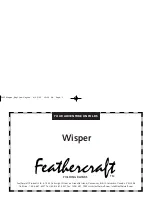
necessary to use tools. As you tighten the wingnut, the valve
shaft (F), plate (D) and seal (E) are pulled up tight against
the hull, sealing off the water access holes (G) and trapping
the water in the ballast tank. As the wing nut is tightened,
the cone shaped washer (H) and rubber seal (I) are pressed
tight against the top of the water tank, sealing the top.
CHECK TO MAKE SURE THE VALVE AND VENT
ARE SEALED:
If the wingnut is loose, ballast water can come into the boat
around the valve shaft, and it can leak out of the bottom of
the hull if the boat leans over. If this happens, ballast is lost
and the boat may no longer be self righting.
While you are sailing and the boat is tipped, check the valve
and air vent to make sure there are no leaks. The more the
boat leans over, the more pressure will be on the valve and
vent, making a leak more likely. Watch them closely.
It is possible to test the watertightness of the lower part of
the valve and its seal by pulling the boat out of the water
with the tank full and valve closed. Check to see if it leaks.
Do this frequently. Preferably every time you sail the boat.
Avoid opening the valve or vent hole in choppy water or
when the boat is leaning, because the water can surge around
in the tank and spill out into the boat. This could flood the
boat. The only time the valve and vent hole should be open
is when you are emptying or filling the tank, or when the
boat is out of the water. Do not leave the valve and vent hole
open and unattended.
14. PREVENTION OF ALGAE IN THE BALLAST
TANK
If you leave the ballast tank full of water for long periods,
drop in a few swimming pool chlorine tablets to prevent a
bad case of algae. Be cautious when handling the chlorine
tablets. Follow the directions on the chlorine tablet container
very carefully. Don’t put chlorine in the galley water tank.
Don’t leave water in the tank in freezing weather. Damage
could result.
15. RETURNING THE BOAT TO ITS TRAILER
Simply drive the boat onto its trailer. Try to steer the nose
into the V on the front of the trailer. Leave the outboard
running to hold the boat against the rubber V pad, and go
forward to secure the nose to the trailer.
Before pulling the boat out of the water, winch the nose
securely to the trailer to prevent the boat from sliding back-
ward off of the trailer. Make sure the boat is centered on the
trailer.
16. EMPTYING THE BALLAST TANK
Open the valve by turning the wingnut (B) counter
clock-wise. Remove the vent hole plug. Pull the boat slowly
out of the water, and the water ballast will begin to drain out
of the boat and back into the ocean. As the boat comes out
of the water, the water level in the tank will be higher than
the water level surrounding the boat. The water in the tank
will try to seek the level of the surrounding water, and the
tank will drain.
If the ramp is steep, and the valve and air vent are open, the
nose of the boat may be higher than the holes in the top of
the tank, and some water may spill into the boat from inside
the tank. This can be remedied by pulling the boat out slowly,
or by keeping the valve and air vent closed until the boat
and trailer reach level ground at the top of the ramp. If the
ramp is steep or slippery, or if your car is feeble, it may not
be able to pull the boat and the 1200 Ibs of water up the
ramp. If so, move forward just a small amount and wait for
some water to drain. Then move forward some more, and
let more water drain. Keep inching forward until the water
is gone. In this manner, you will never have to pull out the
entire 1200 lbs in one swoop.
Do not try to tow the boat with water in the tank. The trailer
was not designed to carry the extra 1200 lb load.
Trailering with the water ballast in the tank will overload
the trailer and probably your car. When trailering, leave the
valve open so all the water can slosh out. There is no sense
in carrying around more water than you have to.
Содержание 26
Страница 13: ......








































